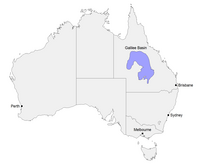
Photo from wikipedia
Abstract Source rock of tight oil is always associated with the tuff layers, i.e., the tuffaceous shale composed of the water-laid tuff and the detrital components. Most previous researchers focused… Click to show full abstract
Abstract Source rock of tight oil is always associated with the tuff layers, i.e., the tuffaceous shale composed of the water-laid tuff and the detrital components. Most previous researchers focused on the influence of the water-laid tuff on the original organic matter (OM) productivity but ignored the organic-inorganic interactions in diagenesis. In this work, the element migration principles in tuffaceous shale was investigated to clarify their influence on the hydrocarbon generation using geochemical methods. Samples are collected from a complete interval of the Upper Triassic Yanchang Formation (Fm.) in Ordos Basin. 17 layers of tuffaceous shale and the adjacent black samples were tested for the mineral element contents, and the Rock-Eval hydrocarbon potential index (PI). Three diagenetic mineral trajectories related to the OM generation and evolution were proposed, i.e., the Fe-S cycle, the devitrification, and the apatite nodule formation, which drew the conclusions as follow: (1) A higher Fe/S value and a higher sulfate mineral content in the reducing environment benefit the hydrocarbon generation; (2) PI of the active tuff in the tuffaceous shale decreases with the zeolitization in the weak acidic or the freshwater environment, and increases with the potash feldspathization in the strong alkaline environment; (3) The alternate growth of apatite and hyalophane nodule could be viewed as an indicator of the organic-inorganic interactions, and the higher Ba/P values would benefit the OM generation.
Journal Title: Fuel
Year Published: 2019
Link to full text (if available)
Share on Social Media: Sign Up to like & get
recommendations!